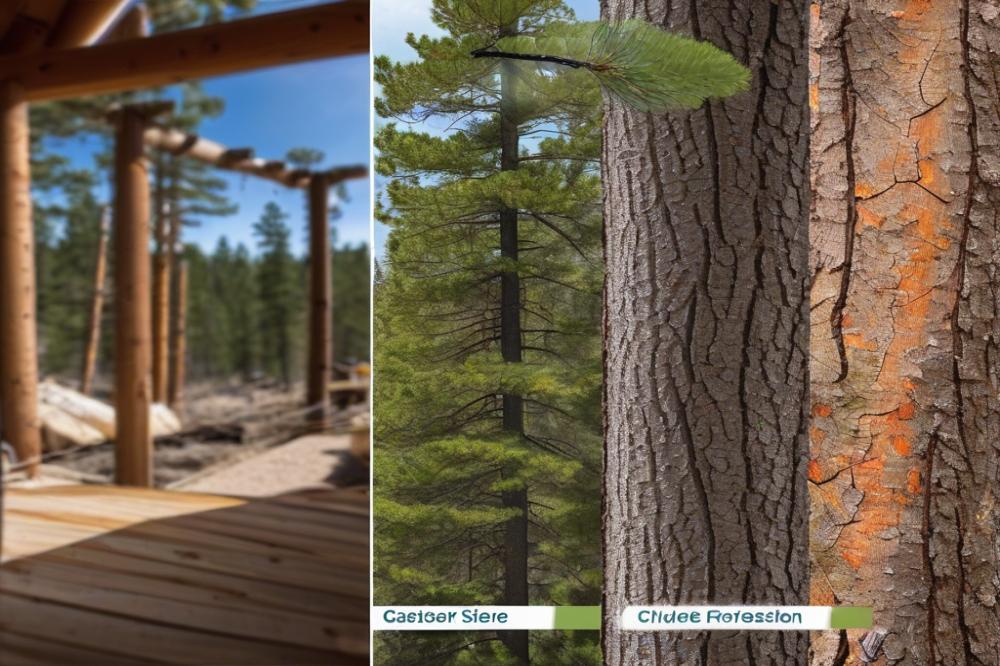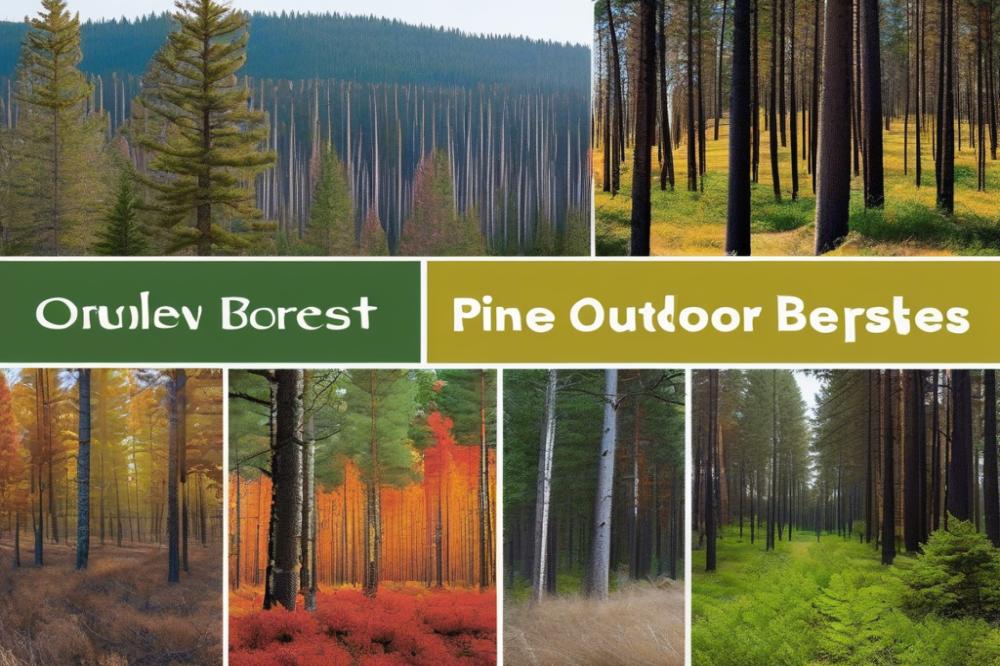Overview of Pine beetle infestations
Pine beetles, particularly the bark beetle, have become a significant problem in many forests. These tiny insects burrow into the bark of trees, disrupting the flow of nutrients and water. Over time, extensive infestations can lead to tree death, affecting not only the trees but also the surrounding ecosystem. Infestations often spread rapidly, making early detection critical for effective management. Noticing the signs early can be the difference between saving a few trees and losing entire areas of forest.
Importance of tree health


Healthy trees contribute to a balanced outdoor environment. Their presence supports local wildlife, purifies the air, and provides shade. When pine trees suffer from beetle infestations, their health declines. This decline can trigger a chain reaction, harming other plants and animals that rely on these trees for habitat. Maintaining the health of your trees should be a top priority. Tree care practices are vital for sustaining a vibrant ecosystem.
Impact on Outdoor Environments


An infestation of pine beetles has far-reaching consequences beyond just the loss of trees. As trees die, they alter the landscape, changing habitats for birds and insects. These changes can disrupt the entire ecosystem, leading to a decline in biodiversity. Soil quality may also suffer without the protective cover that healthy trees provide. Therefore, pest management strategies are crucial. Using prevention methods, such as monitoring techniques, can help control the impact of these pests.
In conclusion, tackling pest issues requires a multi-faceted approach. Awareness of beetle infestations and their effect on tree health is essential. Options available range from insecticides to natural remedies, offering various solutions for those managing outdoor trees. Implementing effective pine beetle control strategies can preserve the beauty and function of our forests.
pine beetle control


Definition and Types of Beetles Involved
Pine beetles are small insects belonging to the family of bark beetles. These pests are notorious for their destructive habits. Various species contribute to beetle infestations in trees. The most common include the Mountain Pine Beetle and the Western Pine Beetle. Each species targets different types of pine trees, leading to distinct challenges. Identifying the specific beetle is vital for effective management. Knowing which beetle is causing problems helps in selecting the right control methods.
Understanding Bark Beetles
Bark beetles live under the bark of trees. They bore into the wood, disrupting the flow of nutrients. This behavior affects the overall tree health. Trees under attack display signs like yellowing needles and excessive resin flow. Some may even die within a few months if not addressed. Monitoring techniques, such as visual inspections and pheromone traps, can help identify infestations early. Early detection is crucial, as it allows for timely intervention.
Relation to Overall Pest Management
Effectively managing pests requires an integrated approach. Pine beetles represent just one element in the broader spectrum of pest management. Both chemical and non-chemical strategies can be useful. Insecticides are often used as a quick fix, but they shouldn’t be the only solution. Natural remedies also exist, such as introducing predatory insects. These methods can help restore balance to the ecosystem impact in affected areas.
Regular tree care can significantly reduce the risk of infestations. Keeping trees healthy strengthens their defenses against pests. Planting a diverse range of species also decreases the likelihood of large-scale outbreaks. Employing prevention methods is essential for maintaining a resilient landscape. Knowledge about local beetle species and their habits will enhance management strategies in your yard or forest.
Signs of Beetle Infestations


Identifying Symptoms of Tree Damage
Pine trees affected by beetle infestations often show clear signs of distress. Look for discolored needles; they may turn yellow or even reddish-brown. Trees might also exhibit thinning crowns, indicating a decline in health. Another symptom includes the presence of sawdust-like frass at the base of the trunk. If you see small holes in the bark, this could signal active tunnels created by the beetles. Each of these signs is important for assessing tree health.
How to Recognize Early Infestations
Detecting early infestations can make a significant difference in pest management. Pay attention to unusual tree behavior during late summer and early fall. Trees may appear weak or stunted compared to their neighbors. Observing the bark is crucial, as you might find tiny pitch tubes where beetles have entered. Catching these early symptoms allows for timely action and offers a better chance for recovery.
The Importance of Monitoring Techniques
Monitoring techniques play a vital role in preventing further damage. Regular checks around your trees can help you stay ahead of any pest issues. Keep a close eye on your trees throughout the year. Use traps specifically designed for bark beetles to identify the problem. Combining these methods with natural remedies can improve long-term tree care. The ecosystem impact of an infestation can be extensive, affecting nearby flora and fauna. By prioritizing observation, you’re making a proactive choice for your outdoor trees.
Impact on Tree Health
Beetle infestations can severely affect tree health. Bark beetles burrow under the tree’s bark. This action disrupts the flow of nutrients and water in the tree. As a result, trees can weaken and die. Symptoms include yellowing needles, wilting branches, and abundant pitch masses on the bark. In a short time, entire stands of trees can be devastated.
Long-term consequences for forests are significant. When trees die in large numbers, it creates gaps in the forest canopy. These gaps allow more sunlight to reach the ground, changing the undergrowth. Some plants thrive, while others struggle. Wildlife that depends on specific trees for food may face shortages. This imbalance can alter the entire ecosystem.
Role of Healthy Trees in the Ecosystem
Healthy trees play a vital role in the environment. They provide habitat for birds, insects, and other wildlife. Moreover, trees help clean the air by absorbing carbon dioxide and releasing oxygen. Their roots stabilize the soil, preventing erosion. A strong tree population supports the health of entire habitats.
Preventing and managing beetle outbreaks is essential. Pest management strategies like monitoring techniques help identify problems early. Natural remedies, such as introducing beneficial insects, offer alternative solutions. In some cases, insecticides may be necessary, but they should be used cautiously. Tree care practices can also help bolster a tree’s defenses against these pests.
Fostering a healthy forest requires attention and action. Landowners can adopt prevention methods to protect their trees. Regular inspections can catch infestations before they spread. Keeping trees in good health is a community responsibility that impacts everyone.
Prevention Methods
Cultural Practices for Healthy Trees
Maintaining the health of your trees is crucial. Healthy trees are better equipped to resist beetle infestations. Start by providing adequate water during dry spells. Regular mulching can help retain moisture in the soil. Additionally, choosing native species for planting promotes a balanced ecosystem.
Pest management also plays a key role in tree health. Limiting the use of chemical fertilizers can enhance natural soil quality. Focus on organic options that contribute to a better growth environment. Proper pruning is essential too; it helps improve air circulation and sunlight exposure.
Importance of Regular Tree Care
Regular tree care cannot be overlooked. Scheduled inspections help catch issues before they become severe. Look for signs of stress, such as discolored leaves or a decline in growth. Monitoring techniques can identify areas that may attract bark beetles.
Caring for trees means being proactive. Make it a habit to check for dead or broken branches. Removing these can prevent pests from finding a home. Additionally, healthy soil supports strong roots, making trees more resilient.
Creating a Resistant Environment
Creating an environment that resists pests is possible with a few strategies. Use natural remedies where applicable, such as neem oil or insecticidal soap. These options can deter harmful insects without harming beneficial ones.
You might consider adding plants that attract natural predators of the beetles. Diverse plant life can create a balanced ecosystem impact. This encourages birds and insects that will protect your trees.
In some cases, insecticides may be necessary. However, they should only be a last resort. Understanding when to apply them takes careful observation. Always read instructions to minimize environmental harm.
Following these prevention methods lays the groundwork for thriving trees. A commitment to consistent care pays off. By being diligent, you can greatly reduce the risk of pine beetle control issues.
Natural Remedies and Integrated Pest Management
Overview of Natural Remedies for Beetles
Natural remedies offer a way to combat beetle infestations without harsh chemicals. For instance, introducing beneficial insects can help control bark beetle populations. Ladybugs and predatory beetles can reduce pest numbers. Essential oils, like neem oil or orange oil, may deter these pests as well. Spraying these oils on affected trees can improve tree health. Another option involves using diatomaceous earth. This powder harms insects by damaging their exoskeletons. Additionally, keeping trees healthy through proper watering and nutrition strengthens their defenses against infestation.
Integrated Strategies for Pest Management
Pest management should not rely solely on one method. Integrated strategies combine various approaches for better results. Monitoring techniques are the first step in this process. Regularly inspecting trees helps identify early signs of trouble. If you see signs of beetles, a combination of remedies is essential. Using traps can capture some pests and reduce populations. At the same time, maintain a healthy ecosystem around your trees. This includes planting native species that attract beneficial wildlife. Healthy trees can often withstand or fight off light infestations on their own.
Combining Natural and Chemical Solutions
Sometimes, it may be necessary to use insecticides to protect your trees. Choosing a targeted insecticide can minimize the ecosystem impact. Chemicals should be used as a last resort when other methods prove ineffective. When integrating these solutions, always be cautious. Application should follow all guidelines to avoid harming beneficial insects. Mixing natural and chemical methods often leads to better control of pests while protecting tree care practices. Balancing prevention methods is key to maintaining a healthy outdoor environment.
Use of Insecticides
When to Consider Insecticides
Pine beetle infestations can lead to severe damage in outdoor trees. When you notice signs of bark beetles, like boring holes or wilted needles, it might be time to act. Early detection is key. If trees appear weak or unhealthy, evaluate the situation promptly. Treating affected trees soon can help preserve overall tree health. Monitor your outdoor space regularly for these pests. Immediate intervention can stop a small problem from spreading into a larger one.
Types of Insecticides Effective Against Pine Beetles
Several types of insecticides are available to combat these pests. Systemic insecticides, which are absorbed by the tree, can be particularly effective. They travel through the vascular system and target insects feeding within. These compounds often provide long-lasting protection. Another option includes contact insecticides. They work by direct application and can kill beetles upon contact. Always choose insecticides labeled for use against bark beetles. Reviews of various products can help in identifying suitable options. Don’t forget to consider any potential risks to other beneficial insects and the overall ecosystem impact.
Best Practices for Application
Application of insecticides requires care and precision. Follow the instructions on the product label closely. Timing is crucial; applying during the active season of beetles heightens effectiveness. Ensure complete coverage of the affected tree areas for maximum impact. Spraying during calm weather can prevent drift to unintended targets. Using protective gear will safeguard your health as well. Rinse application equipment thoroughly to avoid contamination. Additionally, integrating natural remedies with chemical treatments can enhance pest management strategies. Keeping a record of treatments and observing results will aid in future decisions. Regular checking over trees remains a vital component of good tree care.
Final Thoughts on Managing Pine Beetles
Recapping our discussion, various strategies exist for controlling pine beetles in your outdoor trees. Prevention remains key to minimizing the risk of beetle infestations. Regular monitoring can help catch problems early, allowing for quick action. Keeping an eye on tree health is essential; healthy trees are more resilient against pests.
Consider implementing practices like thinning overcrowded areas to improve airflow. This can reduce stress on trees. Proper watering and mulching can also support growth and vitality. Staying informed about the latest management techniques provides an edge against these pests.
Remember that maintaining a balanced ecosystem is important. Healthy forests not only help resist beetle outbreaks but also support numerous other species. By focusing on tree vitality, you contribute to the overall environment’s well-being. Let’s keep our trees thriving and watch for any signs of trouble. With dedication and careful practices, it’s possible to both control pests and nurture the landscape around us.



